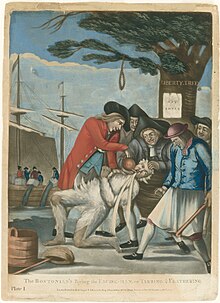Public humiliation
This article needs additional citations for verification. (October 2022) |

Public humiliation or public shaming is a form of
In the United States, it was a common punishment from the beginning of European colonization through the 19th century. It fell out of common use in the 20th century, though it has seen a revival starting in the 1990s.[1] With the rise of the social media, public shaming moved to the digital sphere, exposing and humiliating people daily, sometimes without their knowledge. [2]
Shameful exposure

Public humiliation exists in many forms. In general, a criminal sentenced to one of many forms of this punishment could expect themselves be placed (restrained) in a central, public, or open location so that their fellow citizens could easily witness the sentence and, in some cases, participate as a form of "
Just like painful forms of corporal punishment, it has parallels in educational and other rather private punishments (but with some audience), in school or domestic disciplinary context, and as a

Head shaving can be a humiliating punishment prescribed in law,[4] but also something done as "mob justice"—a stark example of which was the thousands of European women who had their heads shaved in front of cheering crowds in the wake of World War II,[5][6] as punishment for associating with occupying Nazis during the war. Public shaving was applied to (true or alleged) collaborators after the Allied liberated occupied territories from the Nazi troops.[5][6]
Further means of public humiliation and degradation consist in forcing people to wear
Forcing people to go barefoot has been used as a more subtle form of humiliation in past and present cultures. The exposure of bare feet has served as an indicator for imprisonment and slavery throughout ancient and modern history.[11] Even today prisoners officially have to go barefoot in many countries of the world and are also presented in court and in public unshod.[12][13]
Corporal punishment


This article needs additional citations for verification. (November 2019) |
Apart from specific methods essentially aiming at humiliation, several methods combine pain and humiliation or even death and humiliation. In some cases, the pain—or at least discomfort—is insignificant or rather secondary to the humiliation.[14][15][16]
Public punishment
The simplest is to administer painful
Torture marks

The humiliation can be extended; intentionally or not; by leaving visible marks, such as
Psychological effects
Public shaming can result in negative psychological effects and devastating consequences, regardless of the punishment being justifiable or not. It could cause depression, suicidal thoughts and other severe mental problems. The humiliated individuals may develop a variety of symptoms including
Historical examples
- post-mortem public humiliation. See also gibbeting.[citation needed]
- The punishment of public humiliation has taken many forms, ranging from an offender being forced to relate his crime, to a 'shame flute' (for untalented musicians), to the wearing of conspicuous clothing or jewelry (such as an oversized rosary (Dutch: schandstenen, "stones of shame") for someone late to church). The offender could alternatively be sentenced to remain exposed in a specific exposed place, in a restraining device such as a yoke or public stocks.[citation needed]
- In the scaffolding from which one is kicked off to land in mud and dirt.[citation needed]
- In the more extreme cases, being subjected to verbal and physical abuse from the crowd could have serious consequences, especially when the hands were bound, preventing self-protection. Some sentences actually prescribed additional humiliation, such as shaving, or would combine it with painful corporal punishments, see below.[25]
- In adulterers were publicly exposed purely to shame them.[citation needed]
- In Liberia, boy soldiers stripped civilian women to humiliate them; this was described with the verb phrase "to naked someone else."[26]
- In Siam, an adulteress was paraded with a hibiscus behind the ear. Thieves were tattooed on their faces. Other criminals were paraded with a device made of woven cane on the forehead, or lengths of bamboo hung around the neck. Errant Brahmans had to wear a string of oversize beads.[citation needed]
- Send under the yoke was used in ancient Italy.[citation needed]
- Some have considered sex offender registries in the United States to be a form of public humiliation as judicial punishment.[27][28] A convicted sex offender's placement on the sex offender registry is public via a state run website in all 50 states.[29][30] In 2018, a judge in the United States District Court for the District of Colorado declared Colorado's sex offender scheme as unconstitutional, citing cruel and unusual punishment.[31] In 2020, the United States Court of Appeals for the Tenth Circuit overturned that decision.[32]
-
Man and woman undergoing public exposure for adultery in Japan, circa 1860.
-
Flute of Shame displayed at the Torture Museum in Amsterdam.
See also
- Badge of shame
- Bilboes
- Call-out culture, also called cancel culture
- Cashiering
- Charivari
- Cucking stool
- Erotic humiliation
- Humiliation
- Online shaming
- Parading on donkey
- Pillory
- Perp walk
- The Scarlet Letter
- Real-name reporting
- Struggle session
- Tarring and feathering
References
- ^ Deardorff, Julie (April 20, 2000). "Shame Returns As Punishment".
- – via CrossRef.
- ISBN 9780198820314.
- Islamic Penal Code of the Islamic Republic of Iran
- ^ a b Beevor, Antony (5 June 2009). "An Ugly Carnival". The Guardian. Retrieved 13 July 2014.
- ^ ISBN 978-1-85973-584-8
- ^ "Public Humiliation". encyclopedia.ushmm.org. Retrieved 20 May 2023.
- ^ Vinciguerra, Thomas (1 October 2000). "The Clothes That Make The Inmate". The New York Times. Retrieved 20 May 2023.
- ^ "Why the media in Japan, France and South Korea blur the handcuffs on the hands of suspects". ORDO News. 9 April 2022. Retrieved 20 May 2023.
- ^ Borowiec, Steven (3 November 2017). "South Korean Perp Walks: What's Up With the Blurred Handcuffs?". KOREA EXPOSÉ. Retrieved 20 May 2023.
- ^ "Cape Town and Surrounds". westerncape.gov.za. Government of South Africa. Retrieved 18 July 2012.
- ^ Olarn, Kocha (23 January 2013). "Thai court sentences activist to 10 years in prison for insulting king - CNN.com". CNN.
- ^ "Extradition hearing for arms dealer postponed". Taipei Times. 29 July 2008.
- S2CID 144526838. Retrieved 20 May 2023.
- ^ Perlin, Michael L.; Weinstein, Naomi M. (26 December 2014). ""Friend to the Martyr, a Friend to the Woman of Shame": Thinking About the Law, Shame and Humiliation" (PDF). Southern California Review of Law and Social Justice. 24.
- ^ Vellaram, Sandeep; Jayarajan, Sreedevi (1 July 2019). "22 injuries, 'Falanga' torture used: Shocking autopsy of Kerala custodial death victim". The News Minute. Retrieved 20 May 2023.
- ISBN 9781315828367.
- ^ Frevert, Ute (20 January 2021). "The history of humiliation points to the future of human dignity". Psyche.
- ^ "Cat-o-nine tails, United Kingdom, 1700-1850". Science Museum Group. Retrieved 20 May 2023.
- ^ Horan, Leo F. S. (1 September 1950). "Flogging In The United States Navy". U.S. Naval Institute. Retrieved 20 May 2023.
- ^ UN Committee Against Torture. "Convention against Torture and Other Cruel, Inhuman or Degrading Treatment or Punishment Decision No. 551/2013" (PDF). United Nations. Retrieved 20 May 2023.
- PMID 27217887.
- ISBN 978-0-87049-647-9.
- ^ Sieber, Karen (8 February 2021). "The hidden story of when two Black college students were tarred and feathered". The Conversation.
- Colonial Williamsburg Journal.
- ISBN 978-1-59924-827-1.
- JSTOR 23639325. Retrieved 17 April 2022.
- ^ SULLUM, JACOB (25 August 2020). "The Onerous Burdens of Sex Offender Registration Are Not Punishment, the 10th Circuit Rules. They Just Feel That Way". Reason.com. Retrieved 17 April 2022.
- ^ Shim, Jane (13 August 2014). "These States Stick People With a Lifetime of Restrictions for Decades-Old, Nonviolent Sex Offenses". Slate Magazine. Retrieved 17 April 2022.
- ^ "50-State Comparison: Relief from Sex Offense Registration Obligations". Restoration of Rights Project. Retrieved 17 April 2022.
- ^ Mitchell, Kirk (1 September 2017). "Colorado sex offender registration act is unconstitutional, federal judge declares". The Denver Post. Retrieved 17 April 2022.
- ^ "Registration not cruel and unusual punishment, says Tenth Circuit". 23 August 2020.
Further reading
- So You've Been Publicly Shamed, a 2015 book by Jon Ronson on the modern phenomenon of online public shaming on Twitter, Tumblr, and elsewhere on social media.
External links
 Media related to Public humiliation at Wikimedia Commons
Media related to Public humiliation at Wikimedia Commons


